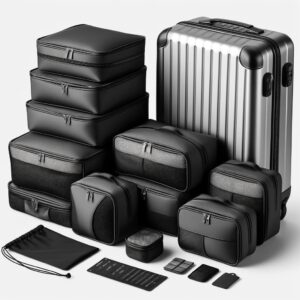Whether you’ve packed a hairdryer, phone charger or electric shaver—once you’re abroad, there’s one question bound to pop up sooner or later: can I just plug this in over here? That’s where two slightly baffling concepts come into play: voltage and frequency.
Sounds technical? Don’t worry. We’ll explain it as if we’re having a natter over a cuppa, not sitting through a university lecture on electrical engineering.
What on earth is voltage?
Voltage—also known as electrical tension—is really just the “push” that drives electricity through a wire. Imagine water flowing through a garden hose: the voltage is like the water pressure.
Here in the UK, that push is 230 volts. In the USA, it’s a gentler 120 volts. And believe it or not, that makes quite a difference to your devices.
If you plug a 230V appliance into a 120V socket, it might sort of work, but not at full steam. Flip it the other way—using a 120V device on 230V—and you risk frying it. As in, actual smoke. Not quite the holiday snap you had in mind, is it?
And what about frequency?
Frequency is a bit like the beat of a tune. In electrical terms, it’s how often the current changes direction every second. We measure that in hertz (Hz). In the UK, it’s 50 Hz. In places like the States, it’s 60 Hz.
Picture a pump pushing water back and forth. If it pumps faster (60 times a second instead of 50), it can affect how your gadget behaves.
Why does this vary from country to country?
Ah, a mix of history and a dash of national pride. Back in the early days of electrification, every country picked its own system. The US went with 110V/60Hz. Europe opted for 220V/50Hz (which later became 230V).
Japan? They decided to really shake things up with two different frequencies in the same country. Standardisation clearly wasn’t on the invite list—which makes things a tad tricky for travellers.
So what does this mean for you as a traveller?
If your gadget is only built to handle a specific voltage or frequency, and you plug it into the wrong type of socket, there are three possible outcomes:
- It works fine (you lucky thing)
- It works poorly or sluggishly
- It goes kaput (!)
That’s why it’s worth giving your plug a quick glance. If it says something like “Input: 100–240V, 50/60Hz”, you’re golden—it’ll work almost anywhere. If it just says “230V”? You’ll want to be cautious in countries that run on 110V. In that case, a voltage converter might be your new best friend.
Voltage and frequency around the world
| Country | Voltage | Frequency | Notes |
|---|---|---|---|
| South Africa | 230V | 50 Hz | Same voltage as UK, different plug shape |
| Japan | 100V | 50/60 Hz | Two frequencies in one country |
| Thailand | 220V | 50 Hz | Hybrid sockets are common |
| Italy | 230V | 50 Hz | Compatible voltage, but different plug types |
| Australia | 230V | 50 Hz | Different socket shape |
| Curaçao | 127/220V | 50 Hz | Voltage varies by region |
| India | 230V | 50 Hz | Same voltage, different plug types |
Do you need a travel adapter or voltage converter?
Sometimes yes, sometimes no.
- Travel adapter: always handy, as plug types vary across the globe.
- Voltage converter: only needed if your device can’t handle the local voltage.
Good to know: most modern chargers (for phones, laptops, cameras) are “dual voltage” and happily work with anything from 110V to 240V.
There you go—no headaches, just handy travel know-how!


